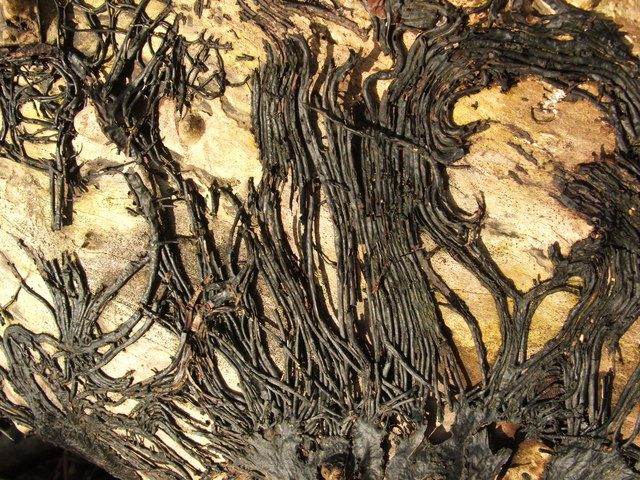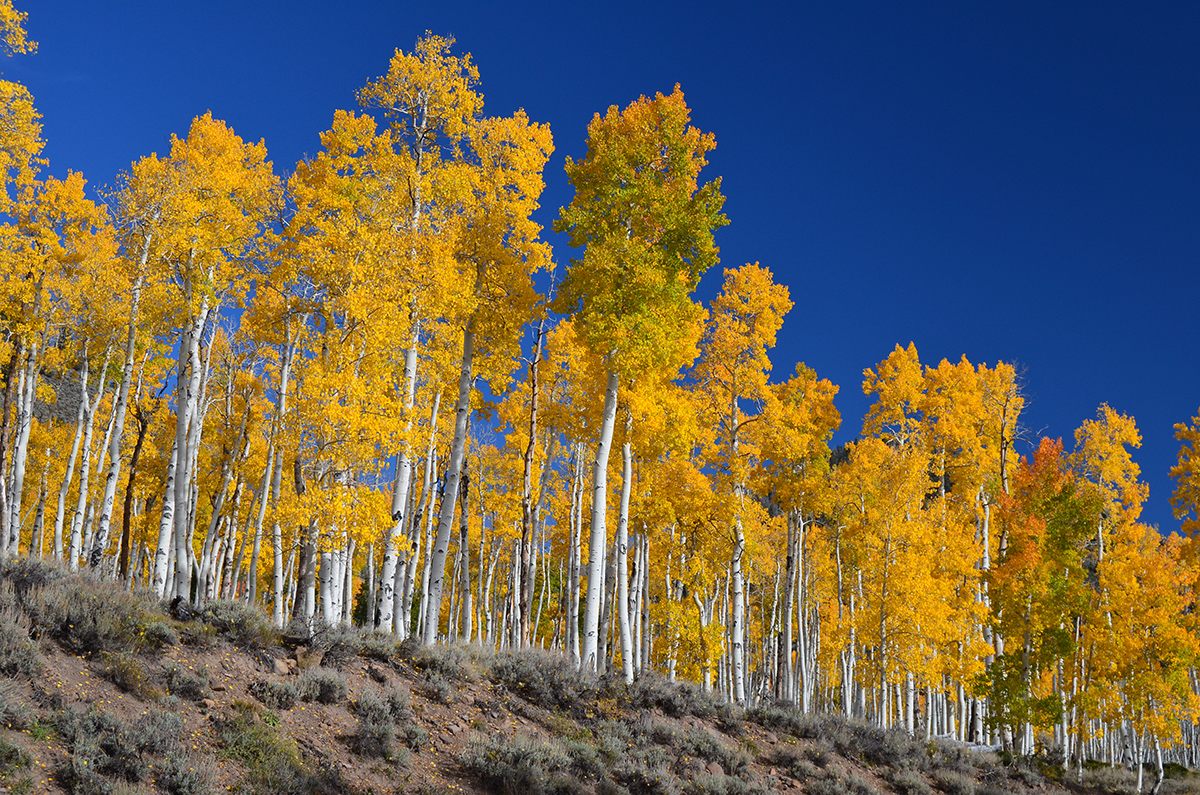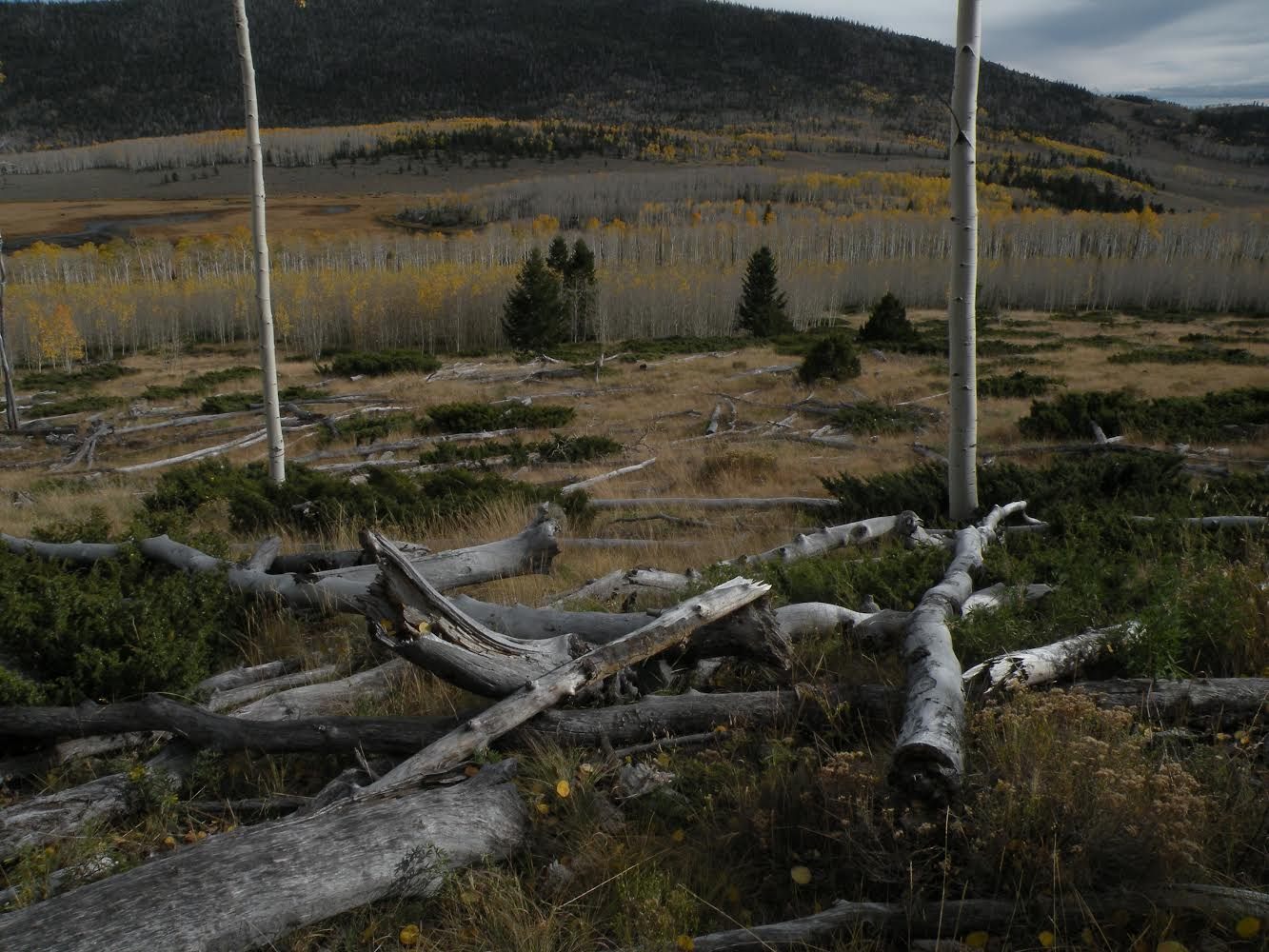How A Fungus And A Tree Translated Underground Hugeness To Mainstream Success

A smaller specimen of Armillaria pokes its caps aboveground. (Photo: Dan Molter/Mushroom Observer CC BY-SA 3.0)
In the late 1980s, a couple of biologists working near a logging site in Michigan’s Upper Peninsula noticed that something was eating the trees. Not the chainsaws, either—something deeper and quieter. For acres, stumps of logged oak trees were dissolved into pulp, and hardly did a new seedling break ground before something strangled it by the roots and began to slowly digest it.
Though they quickly identified the culprit, a fungus called Armillaria bulbosa, attempts at further study led to a much crazier discovery—it wasn’t a bunch of smaller fungi chomping up the forest, but one enormous one. Though the fungus occasionally appeared aboveground, in the form of distinct clumps of mushrooms, the scientists found that most of its bulk was comprised of a billions-strong net of genetically identical tendrils entwined in the earth. “We went out and we sampled,” recalls Myron Smith, “and the first year we covered a large area but we didn’t get to the end of the individual. So the next year we did it again, and we still didn’t get to the end of the individual.”

It seemed to be the largest underground organism on Earth, if not the biggest organism entirely.
Until, of course, it wasn’t.

The rhizomorphs that make up much of a fungus’s mass. (Photo: Lairich Rig/Geograph CC BY-SA 2.0)
By the third year, 1992, they still hadn’t exhausted it. But at this point they’d covered “a pretty big area”—about 37 acres—so they decided to publish their findings in Nature. After a few pages about how to differentiate a bunch of closely related fungi from one giant one, genetically speaking, they pointed out that thanks to their 100-ton discovery, “members of the fungal kingdom should now be recognized as among the oldest and largest organisms on earth,” a distinction that had previously belonged to blue whales, redwoods, and other things for which, as Smith puts it, “you can point to it and say ‘look, that shape over there is a moose.’”
The response was immediate. The New York Times gave it the front page. Stephen Jay Gould used it to wax poetic about different concepts of individuality, and a misguided CNN tried to film the underground mass from the air. Nearby Crystal Falls began throwing an annual Humungus Fungus Fest, even as mycologists worldwide went out hunting, quickly finding an even bigger Armillaria in Washington and, eventually, the current record-holder, in Malheur National Forest, Oregon.

A small slice of Pando looks over Utah. (Photo: J Zapell/USDA Public Domain)
Elsewhere in the country, Michael Grant was skeptical. “I thought to myself, ‘Can’t we have a more aesthetically pleasing ‘largest’ organism?’” he wrote in an email. He had one in mind already, namely, an aspen distributed over about 106 acres of Fishlake National Forest, in Utah.
Like the fungus, this aspen looks from aboveground like a stand of distinct trees, but is really all one enormous clone. A botanist named Burton Barnes uncovered its secret in 1976, when he noticed that leaves from many separate and far-apart aspen trees were indistinguishable, like identical quaking fingerprints.
Grant and a few colleagues put their heads together over Barnes’s paper and did some quick figuring. Then they wrote to Nature, too, purporting that this aspen clone clocked in at “60 times larger than the mass of the Armillaria.” About a year later, in Discover magazine, Grant introduced the world to the tree’s nickname—Pando, Latin for “I spread”—and to its various charms, as though the campaign for the title depended not on the organisms’ respective sizes, but on their personalities.

A bit of Pando from below. (Photo: Scott Catron/WikiCommons CC BY-SA 3.0)
It does, to a degree. The answer to the question “what is the biggest organism?” rests on your definition of both “organism” and “biggest.” In Smith’s mind, he pulled off a coup by convincing the world to invest a giant fungus with individuality at all; Grant’s nudge, though it challenged Smith’s specifics, solidified his overall concept. As far as numbers go, it depends on your criteria—for area, the fungus wins; for mass, it’s probably Pando.
For personality, it’s probably Pando again. In terms of sheer aesthetic pleasure, thousands of graceful trees shading from green to yellow in unison beats out a creeping underground fungus. Its mode of growth is also somewhat more appealing. While Armillaria spreads from food source to food source, identifying, surrounding, and devouring its woody prey, Pando’s literally grows by healing—an asexual growth response means it reacts to any damage by putting up a brand new shoot, a plant version of getting back in the saddle.
The last big point in the tree’s favor might double as its undoing: Pando is an underdog. While the latest humongous fungus, in Oregon, already lives in a protected area, various encroachments on Pando’s territory mean it’s in danger of dying out, says Paul Rogers, director of the Western Aspen Alliance at Utah State University. Experts theorize that Pando “was good at growing fast, and maybe not so great at defending itself,” Rogers says, and as Pando ages, the second part of this trade-off is coming back to haunt it. Though it hasn’t lost any ground, its individual stems are aging and dying; meanwhile, any new growth is quickly eat by local deer or cattle. The result is the kind of population imbalance that frightens any community: “there’s no babies, there’s no teenagers, there’s no middle-aged stems, there’s not even any young senior citizens,” says Rogers. “They’re almost all the same age and they’re dying quickly. It’s a very unsustainable formula.”

An area of Pando that is noticeably losing density. (Photo: Paul C. Rogers/Western Aspen Alliance, Utah State University)
Meanwhile, Armillaria’s formula—grab food, eat food, stay underground—is extremely sustainable. The current most humongous fungus lives in a protected area, and development, though hypothetically devastating, isn’t likely. As such, mycologists can plan studies around its longevity, hoping to use it to learn about long-distance cellular signaling, genetic stability, and “how some organisms can escape the effects of aging,” Smith says.
This particular fungus’s bigness doesn’t interest Smith as much as the fact that, because it’s the biggest, it provides a baseline for such studies.
Scientifically speaking, Rogers doesn’t really care whether Pando is the biggest, either. He readily admits that, depending on how you look at it, the fungus might deserve the championship ring. He just loves aspen, and he sees Pando’s title as a way to help its smaller brethren. “There are other spinoff issues that are important to me,” he says. “Aspen in this country is an enabler of biodiversity. It’s a conserver of water, and water is the #1 issue in the West.” Pando generates media interest, lent its name to an ecological movement, and is even on a postage stamp. If this fame translates to more knowledge, more awareness, or more research funding, Rogers says, “that’s great for me.”
Grant, though frustrated that these efforts haven’t yet led to any sort of official protection, is also reluctant to complain too much. “I think it has stimulated some interest in things botanical,” he writes, “and subsequent work has significantly advanced our understanding and appreciation for the complexity of Pando.” After all, Pando may not be the oldest or the biggest, but, Grant points out, “he is pretty famous.”
Naturecultures is a weekly column that explores the changing relationships between humanity and wilder things. Have something you want covered (or uncovered)? Send tips to cara@atlasobscura.com.















Follow us on Twitter to get the latest on the world's hidden wonders.
Like us on Facebook to get the latest on the world's hidden wonders.
Follow us on Twitter Like us on Facebook